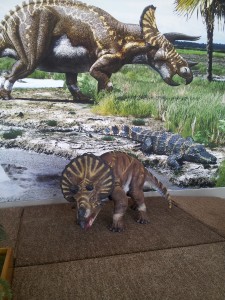
If there is one thing that I am really happy about in terms of how dinosaurs are portrayed in modern popular media, it’s that the public’s perception of dinosaurs as lumbering, uncaring beasts has largely given way to the idea that dinosaurs were intelligent, interesting animals with fascinating behaviours, behaviours that scientists are actively piecing together. However, I think most people, when they think of dinosaurs, usually still think about them as fully-grown animals. Few people think about different kinds of dinosaur eggs and nests, or what we actually know about baby dinosaurs or how dinosaurs grew. Fewer people still seem to know that baby dinosaurs also differed in proportion to adult dinosaurs and also often lacked the horns, hooks, and crests of their adult counterparts.
It’s this aspect of dinosaur palaeobiology, the hatchlings and the dinosaur eggs from which they hatch, that is highlighted in our new temporary exhibit, Tiny Titans: Dinosaur Eggs and Babies, which opened last Friday, Feb. 26, 2016, here at the Philip J. Currie Dinosaur Museum.

Triceratops family photo, including adoptive crocodylian.
This international exhibit features examples of eggs and babies from every major group of dinosaur including meat-eating dinosaurs, sauropods, horned dinosaurs, and duck-billed dinosaurs. The exhibit also features a number of hands-on specimens visitors are able to touch, and many interactive exhibits including a rideable baby Triceratops great for photo opportunities and a replica dinosaur nest in which children can play the role of parents protecting the eggs.
In addition to the large number of play and interactive exhibits, the exhibit also features casts of a number of significant finds including “Baby Louie,” a fossilized dinosaur hatchling currently being researched by Dr. Darla Zelenitsky of the University of Calgary Department of Geoscience. I recently caught up with Dr. Zelenitsky to ask her some questions about Baby Louie, eggs, and hatchling dinosaurs.
Q: What is the scientific significance of Baby Louie?
A: Baby Louie is the only reported specimen of a skeleton associated with the largest known dinosaur eggs (called Macroelongatoolithus [editor’s note pronunciation: MA-kro-ee-LON-guh-too-LITH-us]), and has been key to the identity of these gigantic eggs (and their giant nests). Because of Baby Louie, we now know these eggs/nests belonged to giant oviraptorosaurs. Skeletal remains of giant oviraptorosaurs are exceedingly rare, and Baby Louie represents only the third known specimen. Its early life stage is unique among giant oviraptorosaur specimens, and thus can give insight into how these poorly-known dinosaurs may have changed from baby to adult.

Baby Louie, the articulated hatchling oviraptorosaur from Henan, China. The head is visible on the right, the hips and hind limb are visible on the left.
Q: Where was Baby Louie found? What are some other vertebrates that are known from the same formation as Baby Louie?
A: It is from the [Late Cretaceous] Gaogou Formation of the Xixia Basin of Henan Province [China]. Dinosaur eggs are very common from the Gaogou Formation, with several different types known, including those of theropod, sauropod, and ornithopod dinosaurs. Bones are much less common, although some dinosaur bones (ornithopod) and footprints, as well as turtle bones, are known from this same formation. If you look at formations of equivalent age in the region, there is more vertebrate diversity (fish, turtles, reptiles) represented by bones.
Q: In your opinion, what is the biggest thing that the study of eggs and embryos adds to our understanding of palaeontology?
A: Although there are more dinosaur embryos known today than ever before, they are still rare in comparison to skeletons from later life stages. Embryos provide information on the earliest stages of life of a species, and help us to understand how dinosaurs grew from babies to adults. Eggs can tell us about nesting behaviors and reproduction, aspects of the biology that can be difficult to decipher from skeletons/bones alone.
Q: What do you think the public enjoys the most about dinosaur eggs, embryonic dinosaurs, and baby dinosaurs?
A: I think most people love babies, human or otherwise. People are attracted to their cuteness… related to their small size, large head and large eyes… features that are also present in dinosaur babies.
That’s all for me this week, but be sure to come check out Baby Louie and our other dinosaur eggs and babies on display here at the Philip J. Currie Dinosaur Museum until August 2016!
by Derek Larson
